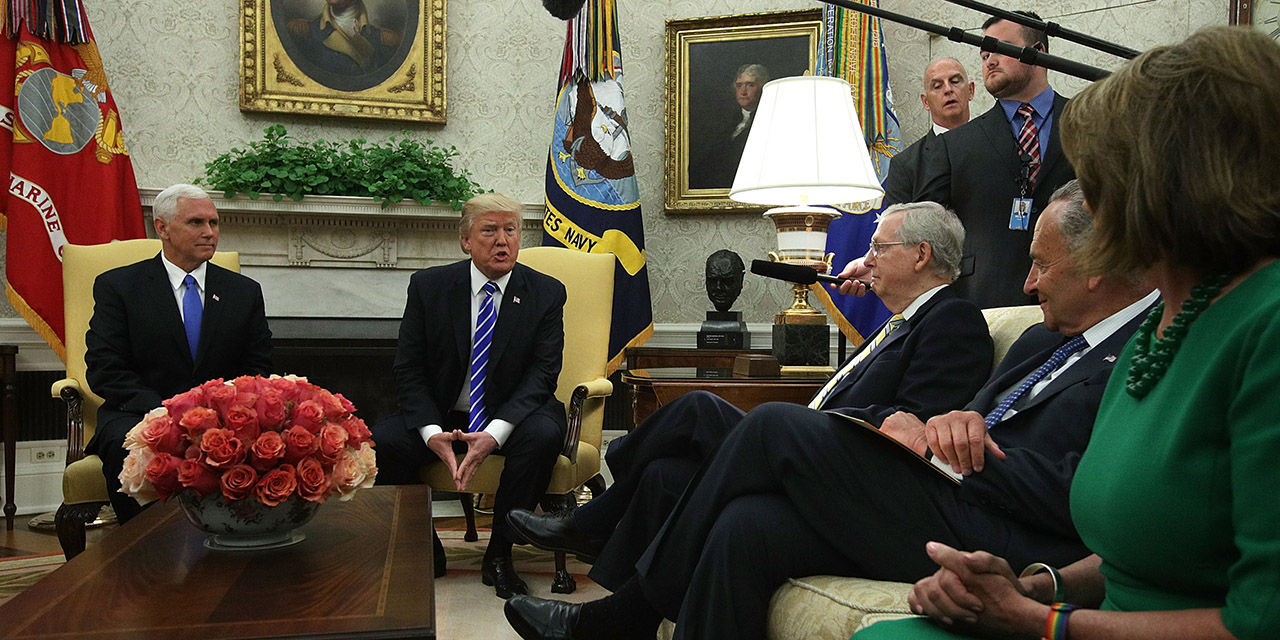President Trump has reportedly cut a deal with Congressional Democrats to kick the can down the road on the national debt. The deal – which has infuriated Congressional Republicans – will extend the debt limit for three months (which will become six months after Treasury raids other government funds to allow even more debt). In doing so, they have rubber-stamped budget deficits that are surging back towards $1 trillion, and a national debt that is on a calamitous path to leap from $20 trillion to $92 trillion over the next 30 years.
This deal surrenders what Washington truly needs: a debt limit showdown. Not one that ends in default – but rather combines significant spending reforms with a modest debt limit increase.
“Raising the debt limit without addressing runaway spending is like offering morphine to a cancer patient: it may provide temporary relief but does nothing to cure the underlying disease.”
Not surprisingly, in Washington, the very idea of placing a statutory limit on the national debt is attracting increased bipartisan criticism as archaic and unnecessary. Critics assert that Congress essentially approves the red ink when it passes the original budget and spending legislation, and that requiring a later vote on whether or not to pay the tab for that legislation is a recipe for chaos and possibly default.
These critics are absolutely correct that – all else equal – requiring regular votes on whether to pay the bills Congress has already incurred is difficult to justify. But all else is not equal, because the budget process also contains extraordinary biases in favor of spending and debt. There are no government-wide spending caps or balanced budget requirements. More than half of all federal spending grows steeply on autopilot every year without any Congressional votes. Existing budget limits can be waived easily with little notice.
Against this hardened institutional bias for spending and deficits, the debt limit vote provides the only guaranteed opportunity for lawmakers to address the total cost of government. And in the past, it has been the only effective tool to rein in deficits.
Here is a little-known fact: Since 1985, virtually every major deficit reduction law has been attached to a debt limit increase. The 1985 and 1987 Gramm-Rudman-Hollings deficit caps were attached to debt limit bills. So were the 1990, 1993, and 1997 budget deals that contributed to the 1998-2001 balanced budgets. The 1996 Line-Item Veto Act (later invalidated by the Supreme Court) and 2010 Pay-As-You-Go law were each placed on debt limit bills. Most importantly, the 2011 Budget Control Act – and its $2.1 trillion spending cut – was attached to a debt limit bill.
Why would lawmakers surrender the only successful tool for reining in deficits? What alternative mechanism could provide this much deficit reduction?
Instead, raising the debt limit without addressing runaway spending is like offering morphine to a cancer patient: it may provide temporary relief but does nothing to cure the underlying disease.
Congress may not have the bandwidth to include the major entitlement savings necessary to stop the red ink. However, several options exist to promote fiscal responsibility:
The best option would put major entitlements on long-term budgets. Top policy experts on the left and right have long endorsed a proposal to put Social Security, Medicare, and Medicaid each on a sustainable 30-year spending path. Every five years, Congress would be required to revisit the programs and ensure they remain on their pre-set path, or else automatic reforms would occur. These long-term budgets are a necessary first step to saving entitlements from their current path to bankruptcy.
Alternatively, lawmakers could extend the Budget Control Act spending caps another five years. These successful discretionary spending caps are scheduled to expire after 2021. While Congress loves to complain about spending caps, recent history shows the absence of caps to be a recipe for runaway spending. Discretionary spending – while no longer driving the deficit – has proven to be the lowest-hanging fruit for lawmakers unwilling to reform major entitlements. And even if Congress continues to loosen the annual caps (including defense) in return for equal savings to smaller, lower-priority entitlement programs, those savings count against the deficit, too.
At minimum, lawmakers should eliminate a budgetary gimmick that essentially helps lawmakers skirt the discretionary caps by $18 billion annually through fake entitlement offsets. Banning this gimmick – called “changes in mandatory programs” or “ChIMPs” – can save $180 billion over the decade.
Failing to raise the debt limit is not an option. Congress must pay its bills. Yet a responsible Congress and president should also include common sense reforms to address this underlying debt – if not now, then next spring when the debt limit returns. Otherwise, lawmakers will find themselves right back in the same spot every year as the mounting national debt drives our taxes upward and our incomes downward.
This piece originally appeared on FoxNews.com
______________________
Brian M. Riedl is a senior fellow at the Manhattan Institute. Follow him on Twitter here.
This piece originally appeared in FoxNews.com
